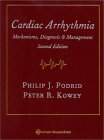1 Anatomy and Physiology of the Conduction System 3
2 Basic Electrophysiology: Generation of the Cardiac Action
Potential 37
3 Mechanisms of Arrhythmogenesis 51
4.1 Genetics of Arrhythmogenic Disorders 81
4.2 Influence of Autonomic Factors and Behavioral State on
Vulnerability to Cardiac Arrhythmias 109
5 The Use of the Electrocardiogram in the Diagnosis of
Arrhythmia 127
6.1 Role of Holter Monitoring and Exercise Testing for
Arrhythmia Assessment and Management 165
6.2 Heart Rate Variability, Signal-Averaged Electrocardiography
QT Dispersion and T Wave Alternans 195
7 Electrophysiologic Testing and Cardiac Mapping 231
8 Antiarrhythmic Drugs 265
9 Cardioversion and Defibrillation 303
10 Cardiac Pacemakers 323
11 Implantable Cardioverter-Defibrillators 357
12 Catheter and Surgical Ablation for Cardiac Arrhythmias 383
13 Sinoatrial/Atrial Tachyarrhythmias 411
14 Atrioventricular Nodal Reentry 433
15 Atrial Fibrillation 457
16 Atrial Flutter 501
17 Tachycardias in Wolff-Parkinson-White Syndrome 517
18 Ventricular Premature Depolarizations and Nonsustained
Ventricular Tachycardia 549
19 Sustained Monomorphic Ventricular Tachycardia 573
20 Polymorphous Ventricular Tachycardia, Including Torsade de
Pointes 603
21 Sudden Cardiac Death 621
22 Sinus Node Function and Dysfunction 653
23 Atrioventricular Nodal Conduction Abnormalities 671
24 His-Purkinje Disease 693
25 Arrhythmias in Hypertrophic, Dilated, and Right Ventricular
Cardiomyopathies 721
26 Arrhythmias in Congenital Heart Disease 749
27 Arrhythmias and Conduction Disturbances Associated with
Pregnancy 785
28 Arrhythmia in Athletes 805
29 Arrhythmias After Cardiac and Noncardiac Surgery 831
30 Periinfarction Arrhythmias 863
31 Arrhythmias in Mitral Valve Disease 889
32 Arrhythmias in Cardiac Transplantation 907
33 Syncope: Pathophysiology, Evaluation, and Treatment 925
Index 945


